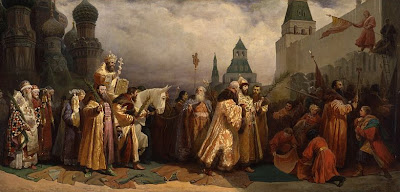When they had come near Jerusalem and had reached Bethphage, at the Mount of Olives, Jesus sent two disciples, saying to them, “Go into the village ahead of you, and immediately you will find a donkey tied, and a colt with her; untie them and bring them to me. If anyone says anything to you, just say this, ‘The Lord needs them.’ And he will send them immediately.” This took place to fulfill what had been spoken through the prophet, saying,
“Tell the daughter of Zion,
Look, your king is coming to you,
humble, and mounted on a donkey, and on a colt, the foal of a donkey.”
The disciples went and did as Jesus had directed them; they brought the donkey and the colt, and put their cloaks on them, and he sat on them. A very large crowd spread their cloaks on the road, and others cut branches from the trees and spread them on the road. The crowds that went ahead of him and that followed were shouting,
“Hosanna to the Son of David!
Blessed is the one who comes in the name of the Lord!
Hosanna in the highest heaven!”
When he entered Jerusalem, the whole city was in turmoil, asking, “Who is this?” The crowds were saying, “This is the prophet Jesus from Nazareth in Galilee.”
Then Jesus entered the temple and drove out all who were selling and buying in the temple, and he overturned the tables of the money changers and the seats of those who sold doves. He said to them,
“It is written,
‘My house shall be called a house of prayer’;
but you are making it a den of robbers.”
What have we in the painting above? (Click on the picture for a larger view.) A historically accurate reenactment of the Gospel account? No, of course not. Why then do we see depictions of Jesus wearing a bejeweled golden crown and expensive fabrics when he would have worn the ordinary clothing of working class males in 1st century Jerusalem, which was an undergarment of coarse cloth and a tunic made of wool? It's true that Jesus' tunic was seamless, which seems to have been unusual, but that's about as far as his finery can be taken. The only crown Jesus wore was a crown of thorns. Even after the Resurrection, when Mary Magdalene first saw Jesus, she thought he was the gardener.
The rule of God—the kingship of Christ—is not about earthly power or political authority, revenge or judgment; it’s about wholeness, it’s about restoring creation to the fullness of peace and justice, truth and love that God intended. It’s about all lands—ALL people—not just a chosen few. It’s about the primary moral value of prizing the interconnectedness of all humanity—of loving our neighbors as ourselves. The kingship of Jesus is AND ALWAYS HAS BEEN vastly different from a worldly kingship. When we celebrate Christ the King, we’re holding up a king who is, first and foremost, a reconciler, a redeemer, a servant. This is a king who comes to show us how to live as a people of God in the kingdom of God—a shepherd willing to lay down his life for his sheep. (Susan Russell - Sermon 2004)
Image from Wikipedia.

An excellent meditation. Would that more who call themselves by the name of Christ would take these thoughts to heart.
ReplyDeleteThanks, Russ. Why do we persist in our attempts to make Jesus what he was not, according to the best accounts we have of his life?
DeleteI have to say, I enjoyed the Feastday of Christ the King a lot more when I did NOT know its (late, Popoid, anti-democracy) origin. Why did Anglicans import this Roman feast day anyway? [There's a Google project]
ReplyDeleteStill love "Crown Him With Many Crowns" and "All Hail the Power of Jesus' Name" though (those hymns certainly long pre-date the feast day).
Jesus turned the power structure of the world upside down in his kingdom, where the poor would be full and the rich sent away empty, and the lowly would be set in the highest places and the greatest sent to the lowest place. THAT is the world in which Jesus is king, the kingdom in which the king is the servant of all.
DeleteI still like the hymns, too, JCF, even as I keep in mind that the words are not to be taken literally. I don't agree with the theology of several of my favorite hymns, but somehow they still work as hymns.
According to Wikipedia, that's actually a historical painting featuring the first Romanov czar, Alexei, and it records a ritual which emphasized the superiority of the Church over the State--that's the czar on foot leading the Patriarch riding on the fake "donkey". I'm sure a Catholic would have no problem with that idea...a secular American, not so sure.... Peter the Great abolished the ritual.
ReplyDelete(see Wikipedia on "donkey walk".
Yes, I saw that, kishnevi. See my link to Wiki. A reenactment...
Delete